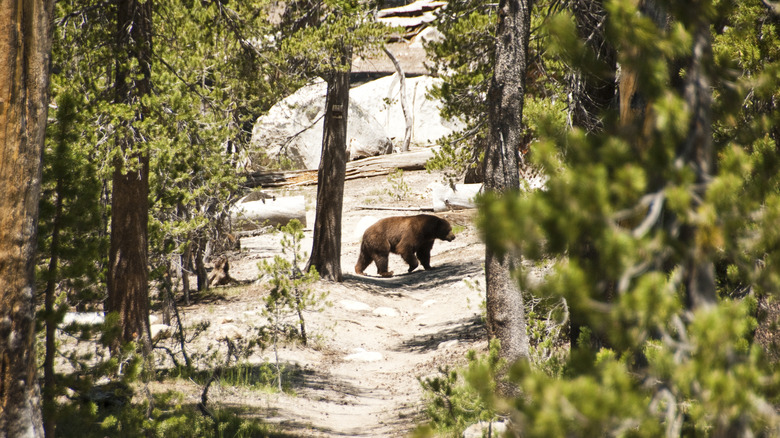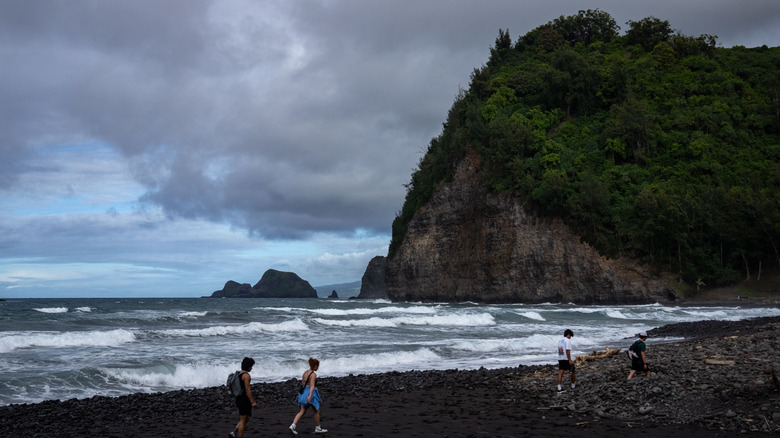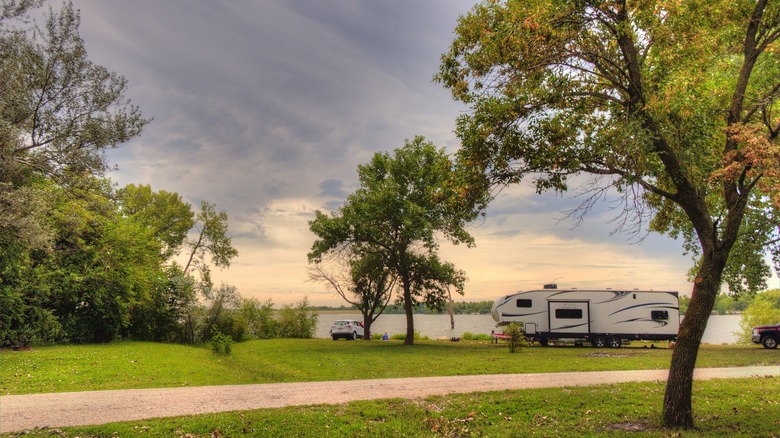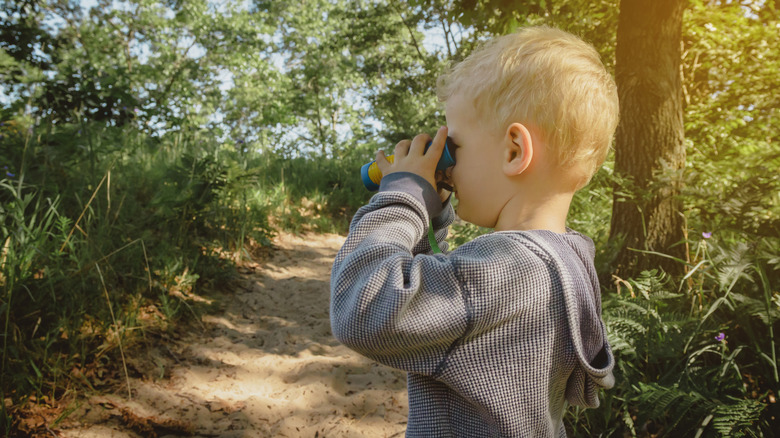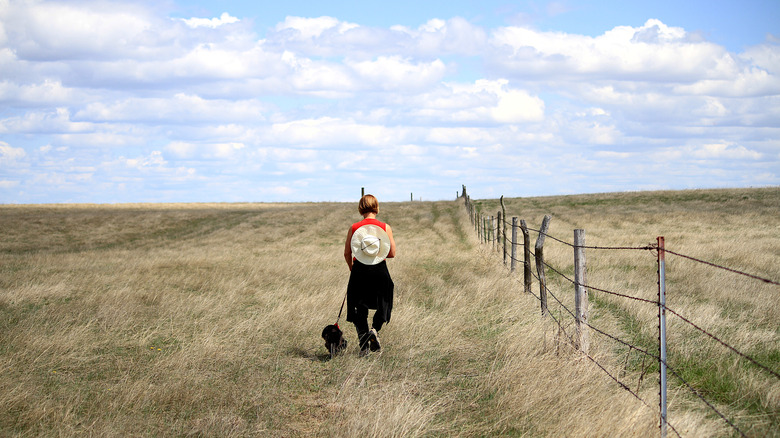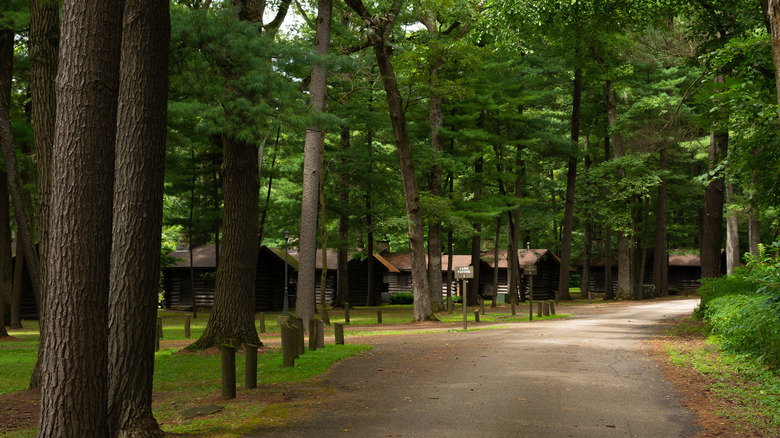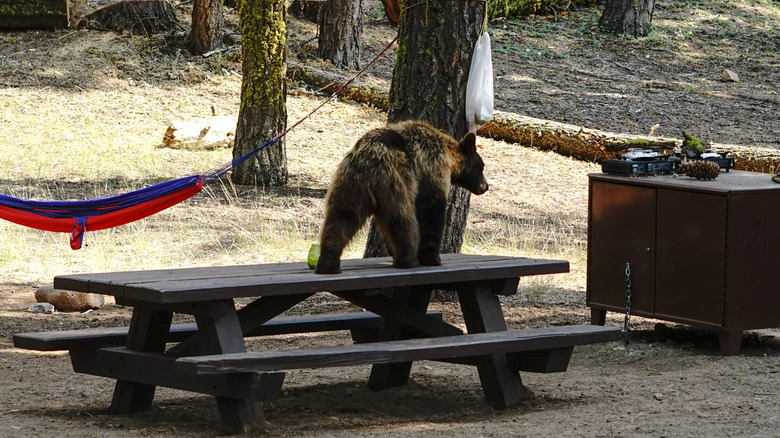America's Top 5 States With The Least Amount Of Bears
You're relaxing in your tent with a good book when you hear it: People on the other side of the campground shouting "Bear!" The shouts get closer and closer, and more of your neighbors start to call out the warning. As they bang their pots and pans and lean on their horns to try to scare the animal away, you might feel nervously excited at the possibility of seeing a bear up close and in the wild ... or you might just be terrified.
Some people travel far from home, seeking out protected wildernesses and national parks where you're almost guaranteed to see a bear just so that they can catch a glimpse of one of the largest carnivores that walks the earth today. Others have a phobia about encountering a bear, regularly hike with their dog, don't want to go through the hassle of hanging their food from trees or lugging around a bear canister, or just can't unsee the scene where Hugh Glass gets mauled by a bear in "The Revenant." If you fall into any of these categories, you might be better off spending time outdoors in one of the states where bears are rare.
If you love hiking, camping, or generally spending time outside in the American wilderness, there's a chance that you're going to encounter bears. While hunting and human expansion have massively reduced polar, brown, and black bear territories, they continue to live in the United States. Polar bears can only be found in Alaska, and brown bears have been relegated to just a few states, but shy black bears continue to live across the United States. Other than the isolated island ecosystem of Hawaii, there aren't any states where you can 100% guarantee there won't be any bears — but you can come pretty close.
Hawaii
If you want to be completely certain that you won't encounter any bears while you're camping in the United States, you're going to have to go to Hawaii. Unless a sun bear breaks out of the Honolulu Zoo, there simply aren't any loose on the islands. And considering it's more than 3,800 miles from Japan and the best swimmers in the bear world (polar bears) can only swim around 60 miles, there's not much chance of that changing without human intervention.
While you can definitely rest assured that you won't spot any bears while hiking around the Islands of Aloha, Hawaii still has plenty of dangerous wildlife that you could encounter on your vacation. Most of them are underwater, though — the Hawaiian hoary bat is the only native land animal in the state. But once you get into the beautiful blue tropical oceans, there are a lot more creatures you might interact with, from sharks to Portuguese man o' wars. Instead of grizzlies, you may find yourself trying to figure out how to avoid box jellyfish on your vacation to Hawaii.
Nebraska
There are snakes in Nebraska's lakes and rivers that make you think twice before taking a dip, coyotes with howls and yips that might sound ominous at sundown when you're tent camping, and even a few elusive mountain lions. Yet it's very unlikely that you will have to worry about running into a bear when you go for a hike in the Cornhusker State. It might seem strange to imagine bears on the prairie, but thousands of years ago, the animals roamed the Great Plains alongside other titans of the Pleistocene era. When explorers Lewis and Clark, led by their trilingual teenage guide, Sacagawea, made their famous expedition west, the bears were still there. While they only encountered a few, it's believed that there were tens of thousands of the animals between the Great Plains and the West Coast. As the land was colonized by European settlers, both brown and black bears were killed or driven out of the Midwest. Today, there are almost no bears in the state.
While there isn't a stable bear population in Nebraska all year long, that doesn't mean they never visit. Occasionally, there are reports of black bear sightings in the state. Some turn out to be false (like one from 2023, which the Nebraska Game and Parks department determined was actually just a very big pig), but there was at least one actual case in 2008. According to a paper from Mammalogy Papers: University of Nebraska State Museum, that year, a young black bear was found in Nebraska and may have been the first to venture there since 1907.
Indiana
In 2021, a series of black bear reports in the state of Indiana shocked residents and experts alike. Up until the 1800s, you could find plenty of the animals living in the area, but as humans cut down forests for agriculture and hunted them, their numbers dwindled to nothing. It had been more than a century since anyone had seen a bear in the state, but increasingly, species from neighboring states visit Indiana for a while before heading back to their home states. Still, that only amounts to one confirmed bear in the entire state of Indiana every year or so. While it's entirely possible that more bears are visiting and then leaving again without ever being detected by humans (or at least before being photographed as proof), the chances of running into one in Indiana are slim.
You're more likely to be close to a stealthy bobcat in Indiana without ever knowing it than to spot a black bear wandering through the Hoosier State. If you really are worried about seeing a bear, however, your best bet would be to visit Indiana in the winter or fall. While the animals are typically most active in fall as they desperately forage for food to tide them over the winter while they hibernate, those venturing into Indiana are believed to be young males getting pushed out of their usual territory by larger, older bears during mating season. This only happens in the spring and summer.
South Dakota
In June 2025, the South Dakota Game, Fish, and Parks Department posted on Facebook advising residents on how to keep their family safe from bears in response to just two reported bear sightings. That might seem unusual in states where neighbors in local community groups regularly post photos of bears in their backyards. But in South Dakota, bear sightings are newsworthy events that shock, terrify, and even delight those who spot them.
It's not the first time in recent years that bears have been spotted in the state, however, and there have been reports of black bears hidden in South Dakota's Black Hills. While there were no proven sightings of bears in the Black Hills between 1960 and 2001, there has been a significant increase since, and locals on social media report seeing them around. However, there are still only a few confirmed bears in South Dakota every year, and they are believed to cross state lines and return to their home territory as the seasons change. While it's a good idea to know what to do if you're out hiking or camping and you see a bear, especially if you're going to be spending time in an area with a recent sighting, it's unlikely you'll actually run into one. You're a lot more likely to see South Dakota's official state animal, the coyote, and will have a lot more to worry about if you meet one of the herds of bison roaming free in the Black Hills.
Illiniois
For the moment, there are no bears living full-time in Illinois, and there have been so few confirmed sightings of black bears passing through the state that they are all listed out by the Illinois Department of Natural Resources (IDNR). Between 2008 and 2024, there have only been seven sightings in total, and two may have been the same bear later in the summer. Another only passed through the state briefly on a journey between Iowa and Wisconsin. A third is believed not to have been a wild bear at all, but an escaped captive bear.
However, there might someday be Illinois bears again. There are populations in neighboring states, which is where Illinois' occasional visitors come from. Potentially, some could decide to stay. There haven't been bears living in Illinois since the late 1800s, but they are protected. Legislation has been passed ensuring that the animals can't be hunted in the state, and if they ever decide to return to Illinois, the IDNR has stated that it wouldn't do anything to prevent it. Illinois is mostly too developed for bears, but there are still a few wild places in the Land of Lincoln — like Illinois' most scenic wilderness destination, the Shawnee National Forest — that they could theoretically call home.
Methodology
To determine the states that have the least amount of bears, we first checked reliable sources like the U.S. Fish & Wildlife Service and the National Park Service to confirm the standard ranges of brown and black bears in the country. Other than Hawaii, there are at least some bear sightings in every U.S. state, so from there, we checked individual state government websites, like the Indiana Department of Natural Resources or the Illinois Department of Natural Resources, to see if the state recognizes an official stable bear population or just has occasional ursine visitors. In states where there are not believed to be bears living all year round, we did a general search for news stories about bear sightings. As we reviewed these stories, we tried to get a general sense of how common bears actually are in the state, considering factors like if the news reported it as part of a larger pattern of bear sightings in the region, a shocking one-time event, or an unconfirmed and controversial incident.
While these are unconfirmed reports, we also looked at social media sites like Facebook and Reddit and looked through comment threads to see if locals regularly reported seeing bears or not. If enough people in a particular region, like South Dakota's Black Hills, seemed to find seeing bears a fairly regular occurrence, we made note of it. In certain circumstances, we also consulted scientific papers and studies to learn more about the distribution of bears in a particular area to provide historical context and help explain why there are so few bears in a particular state. However, these did not contribute to our ranking, other than to confirm that there are very few bears in the region.
